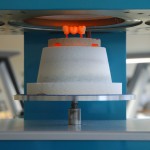
Computer-aided design-computer-aided manufacturing (CAD-CAM) was introduced in the late 1980s as an alternative method of manufacturing dental restorations. Initially CAD-CAM was used for tooth-supported restorations but has developed to include implant-supported restorations. The aim of this systematic review was to identify and summarize the available literature related to CAD-CAM-fabricated implant-supported restorations.
Methods
Searches were conducted in the Cochrane Library and Pubmed. Two reviewers independently selected studies. Studies involving a minimum of 15 patients and a follow up period of at least 1 year were considered. The studies were grouped into studies reporting results on CAD/CAM-fabricated implant-supported, single crowns (SCs), partial fixed dental prostheses (FDPs), and fixed dental full-arch prostheses (full-arch FDPs). Cumulative survival rates for comparable follow-up periods were calculated where possible.
Results
- 12 studies (9 prospective, 3 retrospective) were included
- 1 study reported on single crowns, 1 on FDPs in the posterior maxilla, 10 on full-arch screw-retained FDPs
- Of the 10 full arch FDPs, 6 investigated CAD-CAM screw retained titanium frameworks, 3 zirconia frameworks and one a CAD-CAM chrome cobalt screw-retained framework
- For full arch FDPs survival rates ranged between 92% and 100% with observation times of 1-10 years
Conclusions
The authors concluded: –
Although, CAD-CAM restorations are showing promising results in the short-term, the current scientific evidence is limited due to the restricted quality of the available studies and the paucity of data on long-term clinical outcomes of 5 years or more. There is a strong need for sound scientifically driven studies that aim at the evaluation of the long-term outcome of CAD-CAM-fabricated implant-supported restorations.
Comments
The search undertaken for this review has only included two databases and it is not clear if any language restrictions were applied so it is possible that relevant studies could have been missed. Only one of the included prospective studies was a randomised controlled trial and no assessment of the included studies is reported. The studies sample sizes vary from 16- 183, with an overall total of just 538 patients being included. A number of the studies do not report the length of follow up. Only a qualitative summary was provided owing to variations between the studies. As the review’s authors note the available evidence is both limited and of poor quality.
Links
Patzelt SB, Spies BC, Kohal RJ. CAD-CAM-fabricated implant-supported restorations: a systematic review. Clin Oral Implants Res. 2015 Jun 7. doi: 10.1111/clr.12633. [Epub ahead of print] PubMed PMID: 26061615.

CAD-CAM-fabricated implant-supported restorations – evidence limited http://t.co/O4FP8UItfd
Only limited poor quality evidence available for CAD-CAM-implant-supported restorations http://t.co/O4FP8UItfd
Limited evidence available on CAD-CAM-implant-supported restorations http://t.co/O4FP8UItfd
Little evidence available on CAD-CAM-implant-supported restorations http://t.co/O4FP8UItfd
Don’t miss – CAD-CAM-fabricated implant-supported restorations – evidence limited http://t.co/O4FP8UItfd